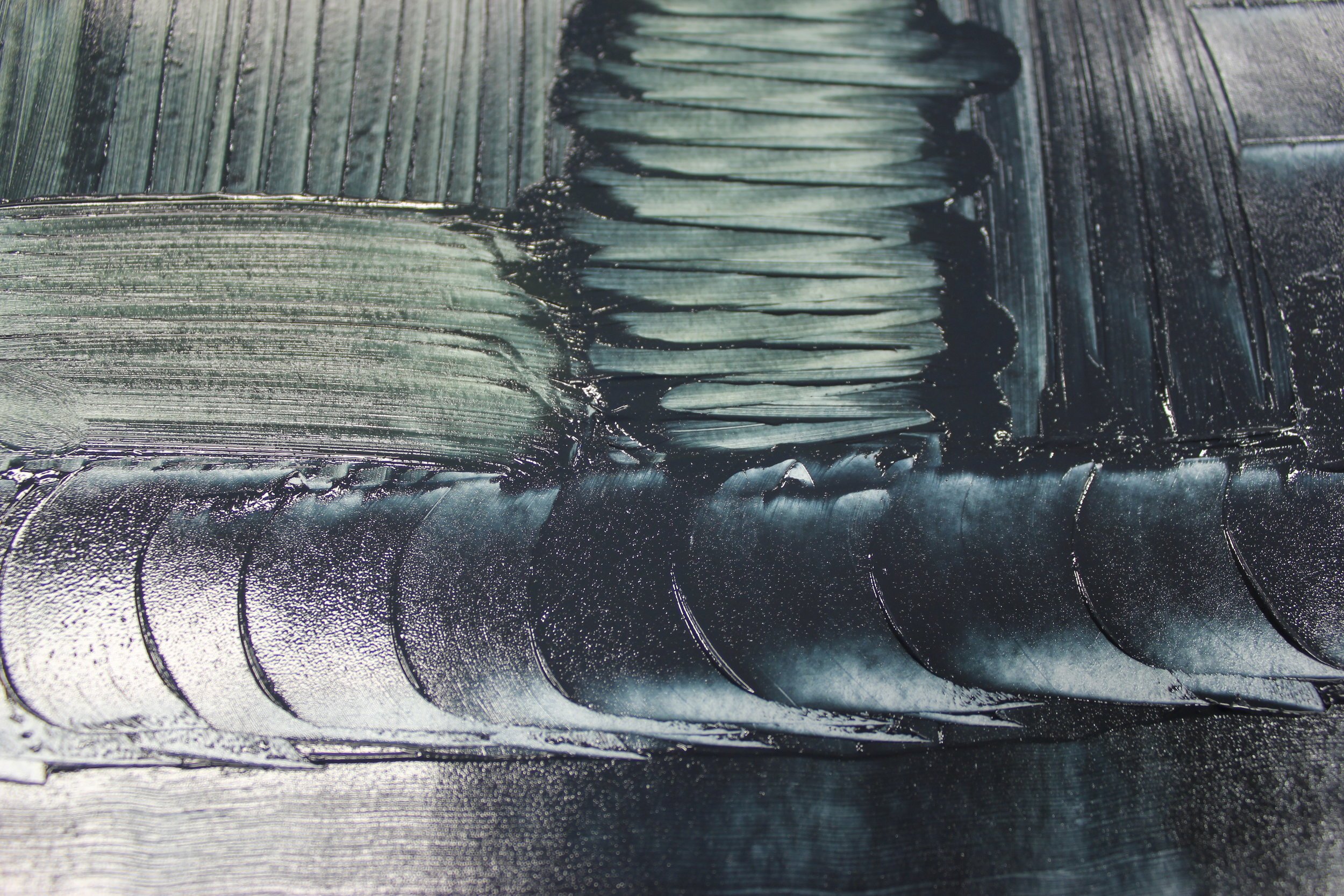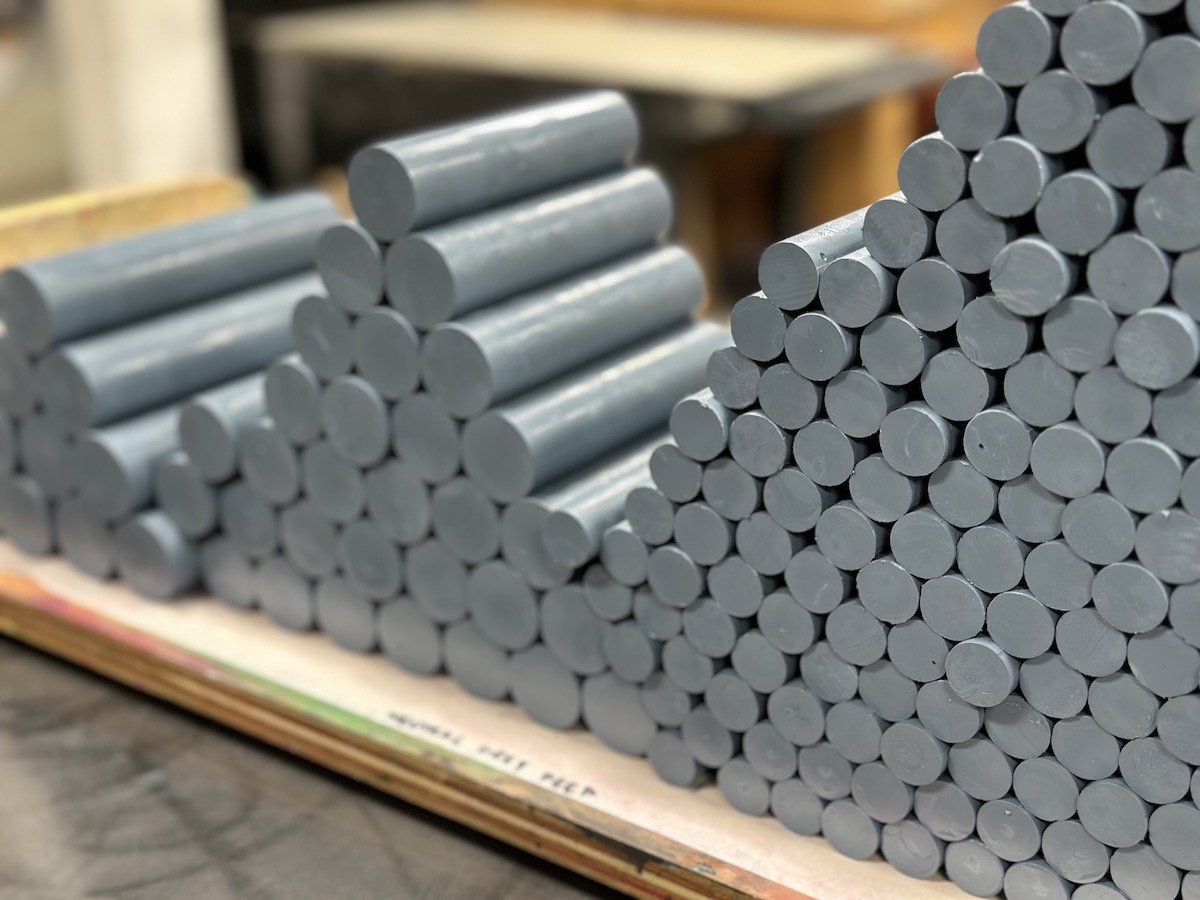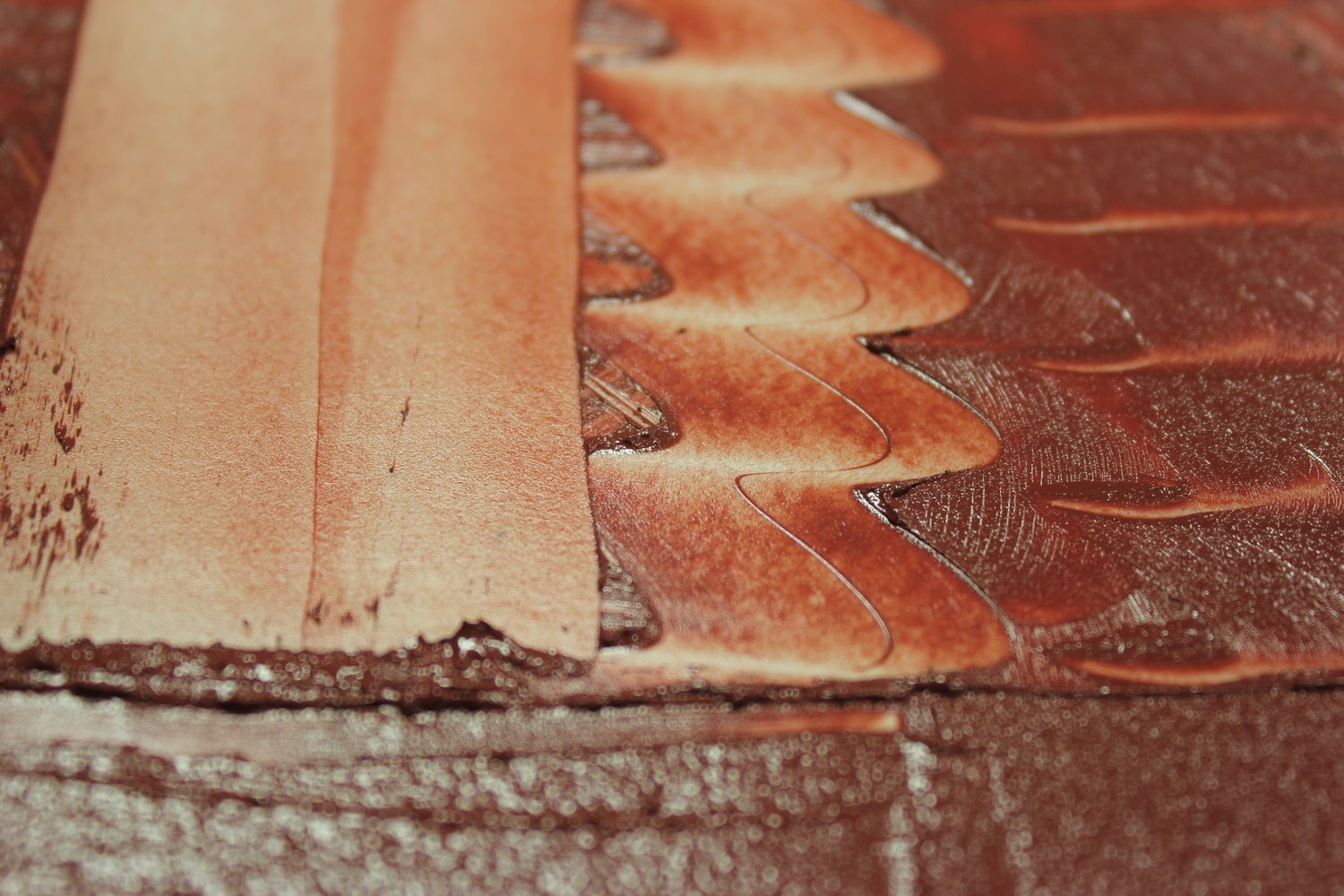Ask Richard: Complex Earths
R&F’s Payne’s Grey Pigment Stick®.
We sat down with R&F founder Richard Frumess recently for another edition of Ask Richard, our segment where we pick his brain on color, paintmaking, and other esoteric art-related questions. In this illuminating conversation, we chatted about the 19 different colors in R&F’s paint lines that are categorized as Complex Earths.
Can you tell us about R&F’s Complex Earths?
Over half the colors in the R&F’s color line are mixes. The Complex Earths especially represent our dedication to the creation of unique colors. Complex Earths are mixes of natural or synthetic iron oxide pigments (collectively referred to here as “earths”) with chromatic pigments (pure reds, yellows, blues, greens, etc.). Each mix contains from two to five pigments.
Doesn’t mixing an earth color with a chromatic color muddy that chromatic color?
One might intuitively assume that, but rather than make the color mixture muddy or neutral, careful addition of an earth lowers the saturation of the chromatic colors to create a less defined, slightly muted, and subtler color. When extended, a Complex Earth shows the particular undertones of its component colors intertwined with one another.
To make Complex Earths, the paint makers at R&F use selective procedures to mill pigments for their optimal characteristics. These laborious processes allow the careful balance of translucent earth pigments with the intensity of opaque and translucent chromatic pigments.
R&F’s Blue Ochre Pigment Stick®
What role do toptone and undertone play in this process?
Toptone refers to the opaque version of any color. The more translucent the pigment, the thicker the paint film needs to be to make it opaque.
Undertone is the toptone extended (diluted) with encaustic medium (for encaustic) or Blending Medium (for Pigment Sticks®).
All pigments, whether opaque or translucent, have an undertone. The undertone of translucent colors, such as Quinacridone Red, is stronger and more saturated than the undertone of opaque pigments like Cadmium Red. Every pigment has its own degree of opacity or translucency. In the case of Complex Earths, each mix of differing translucencies produces undertones that vary depending on how extended the mixed color is.
R&F’s Turkey Umber Greenish Pigment Stick®
What are the Complex Earth colors in R&F’s color lines?
Below are each of the Complex Earth colors divided into 4 different categories so that their usefulness can be better understood. (For a list of the components of each color, scroll to the bottom of this post.):
CHROMATIC BLACKS (Semi-Translucent): Payne’s Grey, Indigo, Blue Ochre, Courbet Green, and Turkey Umber Greenish
CHROMATIC EARTHS (Semi-Translucent): Turkey Red, Magenta Earth, Sap Green, Green Earth, and Olive Yellow
SANGUINE EARTHS & SEPIA (Semi-Opaque): Sanguine Earth (Light, Medium, and Deep), and Sepia
CHROMATIC GREYS (Opaque): Neutral Grey (Pale, Light, Medium, and Deep) and Turkey Umber Pale
R&F’s Burnt Sienna Pigment Stick®
How do the Complex Earths differ from other colors in the R&F line?
Semi-translucent iron oxides, such as Brown Pink and Stil de Grain, and semi-translucent earths, such as the Siennas and Umbers, have complexities and hues that stand apart from the “singleness”of chromatic colors. Mixed with chromatic colors, the translucency of the earth pigments transforms the vividness of those chromatic colors into rich toptones and nuanced undertones.
R&F’s Courbet Green Pigment Stick®
Can you speak about the difference between Chromatic Blacks and Achromatic Blacks?
Chromatic Blacks have a versatility beyond the limited range of the Achromatic Blacks (Ivory, Mars, Intense Carbon, and Lamp Black). While a Chromatic Black can be mixed with chromatic colors alone, such as Phthalo Green with Quinacridone Red, earth pigments give Chromatic Blacks greater hue diversity.
Mixing Chromatic Blacks with white produces an equally diverse range of Chromatic Greys. The toptones of R&F’s Chromatic Blacks look black against light colors. Against dark colors, their color bias gives them a subtle chameleon-like quality in their toptones. When extended, Chromatic Blacks exhibit dark chromatic undertones. Line drawing with Chromatic Black Pigment Sticks can reveal toptones and undertones that have greater tonal variety than lines produced by Achromatic Blacks.
Courbet Green is a good example of this color bias. Its toptone when surrounded by a Cadmium Red, is black. Surrounded by Mars Violet, it is a greenish grey. Surrounded by Blue Ochre, both colors take on variants of black. But surrounded by one of the Achromatic Blacks, it suddenly becomes a definite, but somber, green. When extended, its undertone is a brackish green. Extended further, it becomes translucent grey. With white, it becomes a greenish grey.
R&F’s Neutral Grey Deep Pigment Sticks® stacked and waiting to be wrapped by hand in our production facility.
How do the Chromatic Earth colors function in painting?
In contrast to Chromatic Blacks, Chromatic Earth colors have fuller chroma and warmth. Their earthiness, which is more subdued than fully saturated colors, gives them the quality of rich intermediate colors that can transition between both saturated colors and neutral colors. Their lower saturation also makes them more easily influenced by other colors, which can make them seem warmer or cooler, purer or duller. The undertones of the Chromatic Earths are equally rich but strikingly more luminous than their top tones.
The more Chromatic Earths are extended with medium the more the strongest undertones dominate. Turkey Red is an example. The combination of Raw Sienna, Quinacridone Red, and Indian Yellow creates a push and pull between the Raw Sienna’s earthiness and the vibrant clarity of the Quinacridone Red and Indian Yellow undertones. The Raw Sienna gives a rich warmth to the red toptone. But when the Turkey Red is extended, it reveals a glowing orange-yellow interplay of the red and yellow tinged with the Raw Sienna.
Because the Indian Yellow has the strongest undertone of the 3 pigments, the more it is extend, the yellower the orange becomes. Cadmium Red Deep pushes the toptone of Turkey Red toward brown, Cadmium Yellow Deep toward red, Cobalt Blue toward purple. Tinting the Turkey Red with white creates a very muted neutral pink.
R&F’s Sanguine Earth Deep Pigment Stick®
The Sanguine Earths and Sepia are made only in Pigment Sticks®. R&F developed these colors as oil paint versions of Conté sanguine crayons. Just enough white is added to give Sanguine Earths and Sepia a chalky toptone. By contrast, when extended, these colors have a surprisingly saturated undertone.
Reminiscent of the Renaissance reddish drawing chalks, all four colors can be used singly or together to create monochromatic figure drawings, landscapes or abstract color fields. Their muted saturation enables them, like the Chromatic Earths, to serve as the intermediate transitions to fully saturated colors, pale tints, and darker hues.
R&F’s Turkey Umber Pale Pigment Stick®
In what ways have artists historically worked with neutralized colors?
Diebenkorn used complex variants of grey to offset and make vibrant subdued chromatic colors. Morandi used them to create meditative transitions to slightly saturated colors. The ambiguity of R&F’s Complex Greys makes them easily influenced by more saturated colors, which push the greys in different directions of hue, temperature, saturation, and value.
Just as the Chromatic Blacks have more versatility than “true” blacks, the Chromatic Greys contain hints of their component pigments, which offer a wider range of color relationships than simple black-and-white mixes. Tinting any of the Chromatic Blacks with white adds to the range of Complex Greys. Turkey Umber Pale is a good example of this mutability. Against white, it is a subtle yellowish-green neutral. Chromium Oxide Green pushes it toward blue, Cobalt Blue towards yellow, Cadmium Red toward green.
Our four Neutral Greys range in value from pale to deep. They are composed of Raw Umber, Cobalt Blue, and Titanium-Zinc White mixes. Set against their component color Raw Umber, they shift blue. Against Cobalt Blue they shift toward greenish brown.
R&F’s Sepia Pigment Stick®
CHROMATIC BLACKS (Semi-Translucent)
Payne’s Grey: Burnt Umber, Ultramarine Blue + Quinacridone Red
Indigo: Raw Umber, Prussian Blue + Ultramarine Blue
Blue Ochre: Raw Sienna + Cobalt Blue
Courbet Green: Burnt Sienna, Phthalo Green, Cadmium Yellow Dp
Turkey Umber Greenish: Raw Umber + Phthalo Gree
CHROMATIC EARTHS (Semi-Translucent)
Turkey Red: Raw Sienna, Quinacridone Red, Indian Yellow
Magenta Earth: Stil de Grain, Quinacridone Magenta
Sap Green: Brown Pink, Phthalo Green, Indian Yellow
Green Earth: Stil de Grain, Viridian, Ultramarine Blue
Olive Yellow: Stil de Grain, Cadmium Yellow Light, Ultramarine Violet
SANGUINE EARTHS + SEPIA (Semi-Opaque)
Sanguine Earth Light: Stil de Grain, Brown Pink, Quinacridone Red, Titanium-Zinc White
Sanguine Earth Medium: Brown Pink, Quinacridone Red, Titanium-Zinc White
Sanguine Earth Deep: Brown Pink, Quinacridone Magenta, Titanium-Zinc White
Sepia: Brown Pink, Quinacridone Magenta, Ultramarine Blue, Titanium-Zinc White
Note: Sanguine Earths are made only in Pigment Sticks. Sepia is made in both Pigment Sticks and encaustic.
CHROMATIC GREYS (Opaque)
Neutral Grey Pale, Light, Medium, Deep: Raw Umber, Cobalt Blue, Titanium-Zinc White
Turkey Umber Pale: Raw Umber, Phthalo Green, Titanium-Zinc White
Note: Neutral Greys are made only in Pigment Sticks.
To learn more about Achromatic Blacks, Chromatic Blacks, and Chromatic Whites, visit rfpaints.com.
To download an R&F Color Chart, click here.









